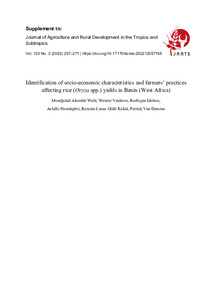Identification of socio-economic characteristics and farmers’ practices affecting rice (Oryza spp.) yields in Benin (West Africa)
| dc.date.accessioned | 2023-01-03T12:24:27Z | |
| dc.date.available | 2023-01-03T12:24:27Z | |
| dc.date.issued | 2022-12-28 | |
| dc.identifier | doi:10.17170/kobra-202212057195 | |
| dc.identifier.uri | http://hdl.handle.net/123456789/14320 | |
| dc.language.iso | eng | eng |
| dc.rights | Namensnennung 4.0 International | * |
| dc.rights.uri | http://creativecommons.org/licenses/by/4.0/ | * |
| dc.subject | smallholders | eng |
| dc.subject | rice cultivation | eng |
| dc.subject | irrigation | eng |
| dc.subject | crop rotation | eng |
| dc.subject | mineral fertilisers | eng |
| dc.subject.ddc | 630 | |
| dc.title | Identification of socio-economic characteristics and farmers’ practices affecting rice (Oryza spp.) yields in Benin (West Africa) | eng |
| dc.type | Aufsatz | |
| dcterms.abstract | Rice (Oryza spp.) is one of the major staple foods in Benin. Benin has increased rice production through the expansion of cultivation area rather than increasing rice yields. To better understand the factors affecting rice yields, a thorough understanding of the current rice production system characteristics and constraints is required. The present study identifies socio-economic characteristics and farmers’ practices affecting rice yields and suggests improved cultivation practices in the sector. Data were collected through semi-structured interviews, including socio-economic characteristics and rice cultivation practices from 230 randomly selected rice producers in North and Central Benin. Descriptive statistics and cluster analysis were used to group rice producers into different groups. Findings revealed that the proportion of rice producers having access to credit was low (33.5 %). Out of seventeen variables, only three (lowland rice cultivation, irrigated rice cultivation and total land cultivated area) discriminated best the rice producers in three (03) clusters with distinct characteristics in terms of socio-economics factors and cropping practices affecting rice yields. Most respondents (more than 70 %) did not practice crop rotation or fallow. This, together with low levels of chemical fertiliser applications and type of rice cultivation, explains poor rice production in particular in clusters 1 and 2. Yield enhancement is possible through the combination of lowland and irrigated cultivation performed by farmers in cluster 3 with the highest mean rice yield (3.8 t.ha-1). We suggest tackling the specific characteristics and needs of rice producers would more adequately help to improve rice yields. Interventions to enhance rice yields include training on best rice production practices, provision of input subsidies and access to irrigation tailored to the specific constraints and needs of each rice grower type. Finally, enabling access to credit will improve productivity of rice farmers in Benin. | eng |
| dcterms.accessRights | open access | |
| dcterms.creator | Wabi, Moudjahid Akorédé | |
| dcterms.creator | Vanhove, Wouter | |
| dcterms.creator | Idohou, Rodrigue | |
| dcterms.creator | Hounkpèvi, Achille | |
| dcterms.creator | Glèlè Kakaï, Romain Lucas | |
| dcterms.creator | Van Damme, Patrick | |
| dc.subject.swd | Benin | ger |
| dc.subject.swd | Kleinbauer | ger |
| dc.subject.swd | Reisanbau | ger |
| dc.subject.swd | Bewässerung | ger |
| dc.subject.swd | Fruchtfolge | ger |
| dc.subject.swd | Mineraldünger | ger |
| dc.type.version | publishedVersion | |
| dcterms.source.identifier | eissn:2363-6033 | |
| dcterms.source.issue | No. 2 | |
| dcterms.source.journal | Journal of Agriculture and Rural Development in the Tropics and Subtropics (JARTS) | eng |
| dcterms.source.pageinfo | 257-271 | |
| dcterms.source.volume | Vol. 123 | |
| kup.iskup | false |
Dateien zu dieser Ressource
Das Dokument erscheint in:
-
Vol 123, No 2 (2022) [10]



